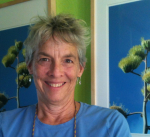Going Far Enough
 Saturday, September 19, 2009 at 12:41PM
Saturday, September 19, 2009 at 12:41PM  Detail, Eve Leaves, 2009
Detail, Eve Leaves, 2009
In your work.
One of the principle differences I see between "beginners" and seasoned artists is the willingness to go far enough with an idea, a material, a vision, a technique. It's a fact of cognitive psychology that we humans have a interesting condition for learning. We need to have a certain degree of familiarity, safety. And we have to have something that pushes us into new territory, a little risky feeling, an edge of the unknown, a bit of discomfort -- it's called cognitive dissonance.
 Sample, watercolor crayon print
Sample, watercolor crayon print
This past week I took a journey into cognitive dissonance. I spent the better part of the week exploring and pushing myself in a familiar arena, using watercolor crayons with gel medium to produce multicolor images -- one of the techniques I've been using since I began working in this field. I had two reasons for the task: I am teaching a one-day workshop at the International Quilt Festival in Houston on Thursday, October 15, "Rainbow Prints with Watercolor Crayons." I wanted to be up to speed with some new media and have some fresh samples and examples to share. (There's still room for a few more participants in this workshop, you can find out how to register by going to website, www.quilts.com.)

Secondly, I am attending a meeting right after Festival of the Art Cloth Network, a small national organization of about 25 artists who spend dedicated time and energy investigating and creating art cloth, or, as Jane Dunnewold, calls it "complex cloth." Sixteen years ago I began a serious pursuit of my life as a working artist in classes with Jane (and her faculty) at the Southwest School of Art and Craft. My entry into art quilts, where I spend much of my energy now, came after I began making and learning about complex cloth, and I continue in that world with art cloth pieces, and in the surface design that I use for fabrics that become part of my quilts. But over the past few years, I have found myself less myself in my art cloth than I am in my art quilts. I have felt that though my work can be strong, it doesn't have the depth of expression or the true individuality that I think I have found in my art quilts. Much of the art cloth I make ends up being cut up to use in my art quilts, not a bad end for it, but kind of a denial of the art cloth "movement," which promotes the creation of beautiful, artful and meaningful cloth as a end process, not just something to be used for something else. So, I thought that if I took a technique and an image I love, worked with it towards art cloth, I would actually have some fabric I ws interested in to take to the conference for our show-and-tell!

If you are still with me, forgive the long introduction -- but sometimes its good to pinpoint exactly where one is in the process. So the week of work, it worked!

Not only do I have some new interesting media that proved to be easier to use (especially in the IQF setting without cleanup sinks!), some adaptations that make the technique even more interesting and varied, but I also had a breakthrough for my art cloth work. I have discovered a new direction to follow for my art cloth that seems to have a relationship to my art quilt work, in that it is more narrative and more "imagetic" than what I have been doing. You've seen the warmups in samples as you've read this diatribe and here are the first two lengths of art cloth (I confess, I might want to try making a whole cloth quilt with one or the other someday -- also something I've never tried). These are, I warn, Works In Progress. Neither is completely successful as a final art object, but I learned an enormous ammount simply pushing myself into a new realm of work. One question that arises: when does a piece of art cloth become a painting on cloth. Or does that matter? What do you think?
 "Eve Leaves," Art Cloth, 2009, mixed media, watercolor crayons, screen-printed
"Eve Leaves," Art Cloth, 2009, mixed media, watercolor crayons, screen-printed "Hummingbird and Century Plant" 2009, Art Cloth, mixed media , watercolor crayons, screenprinting
"Hummingbird and Century Plant" 2009, Art Cloth, mixed media , watercolor crayons, screenprinting
I've also completed a handout about the technique of using watercolor crayons and polymer medium that I'll use at the Festival. It goes through the basic process and tools for this technique and you are welcome to download it here. (Link is yet to be figured out. coming soon!) Email me for an attachment pdf to be mailed to you.





